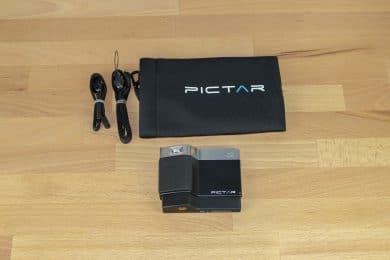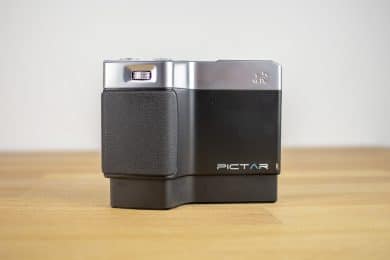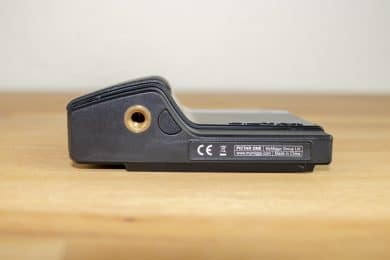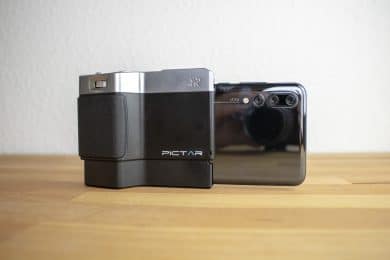
With the “Pictar One” or “Pictar One Plus” Miggo wants to turn smartphones into real cameras. The attachment, based on a classic photo camera, is simply pulled over the smartphone – then photos can be taken at the touch of a button, similar to a camera. We want to clarify with our test to what extent the device is actually needed, what practical benefits it offers and whether it is recommendable overall.
Design and Workmanship
The smartphone case wants to remind you of an old-fashioned camera, which works well. All in all, the design is consistently oriented towards the goal of reproducing a classic camera of recent decades in almost every respect. Anyone who likes classic accessories will certainly be delighted by Pictar One. The Pictar One Plus is, by the way, a larger model for larger smartphones, as they are currently in fashion.
Far less appealing than the design is the workmanship of the camera attachment. The largest part of the device is made of plastic. Optically it conveys a high-quality impression due to the outstanding design – but haptically this is not confirmed. The cover does not feel very high quality and also the buttons look rather mediocre.
The fact that the smartphone sits very firmly in the camera shell is a particularly positive feature. At no point in the test did we have to fear that it might fall out and be damaged. The included straps, which can be attached to the wrist, also contribute to a good operability and a firm fit of the entire device.
Equipment
Since it is a smartphone attachment, the equipment is not very extensive. At this point, it should be noted that the tested device is by no means a camera or the like. The Pictar One is merely a cover that looks like a camera and can be activated at the touch of a button to activate the smartphone’s camera.
For this purpose, the camera-like case is equipped with a slot for a clip-on flash, a shutter release and two setting wheels. One of these wheels is responsible for adjusting the image brightness while the other wheel is used for mode selection. There is also a zoom ring that can be used to switch between the main and front camera of the inserted smartphone. A thread on the underside, which makes it possible to attach a tripod, rounds off the equipment of the Miggo Pictar One.
All in all, everything is available that a camera-imitating case needs – it can be attached, photos can be taken and basic settings can be made.
Function or Power
Probably the biggest feature of the Miggo case is that the connection to the smartphone is not established via Bluetooth. Instead, pressing a button generates a high-frequency sound that is picked up by the microphone of the smartphone inserted. Recording the sound signal in turn triggers the action in the Pictar app for which the button pressed in each case is responsible. However, the sound produced is not audible.
Pictar sees this type of connection as advantageous. This eliminates the need to connect the case to the smartphone, for example. This will also help to save electricity. In fact, however, the test reveals disadvantages that are directly related to the sound-borne connection. Since the sound only leads to a reaction in the Pictar app, photos can only be taken with these photos. Those who are used to taking photos directly in Instagram, Snapchat and Co will be disappointed by Pictar One.
Taking photos works perfectly in the test, however. Also the different settings – Pictar offers for example a sport mode – seem to be quite useful. It is noticeable, however, that in some cases the camera is triggered with a slight delay. So it might be quicker to just tap the touchscreen to take a picture.
App
As mentioned in the previous paragraph, the camera attachment only works in conjunction with the Pictar app. Among other things, it is possible to carry out a manual ISO check to avoid grainy or blurred images. At the same time the brightness can be adjusted. Various preset modes are also available and can be set as desired. In this way it is possible to influence the camera. Ultimately, however, the user remains bound by the limitations of his smartphone.
The app is ultimately the highlight of this test. It also offers a timer function, the ability to adjust focus at the touch of a button, use filters, etc. All in all, the range of functions is quite broad, which of course represents a big plus point.
Despite the many options that the app offers, it is very clearly designed and easy to use. We quickly found our way around the test and were very impressed by the clear structure.
Conclusion of the Miggo Pictar One Review
It is difficult to draw a final conclusion. The case is visually appealing and allows you to get the most out of your smartphone’s camera. In the end, however, she by no means transforms it into a fully-fledged photo camera. Photography lovers will be pleased to be able to use their mobile phone like a camera – but the material used and the quality of workmanship leave much to be desired. So Miggo can’t convince us with the Pictar One, which Pictar One Pro, which was recently introduced, but lets us hope for a better quality.
Miggo Pictar One
Design & Workmanship
Features
App
Value for Money
A gadget whose approach is interesting, but unfortunately too expensive for the material quality.







